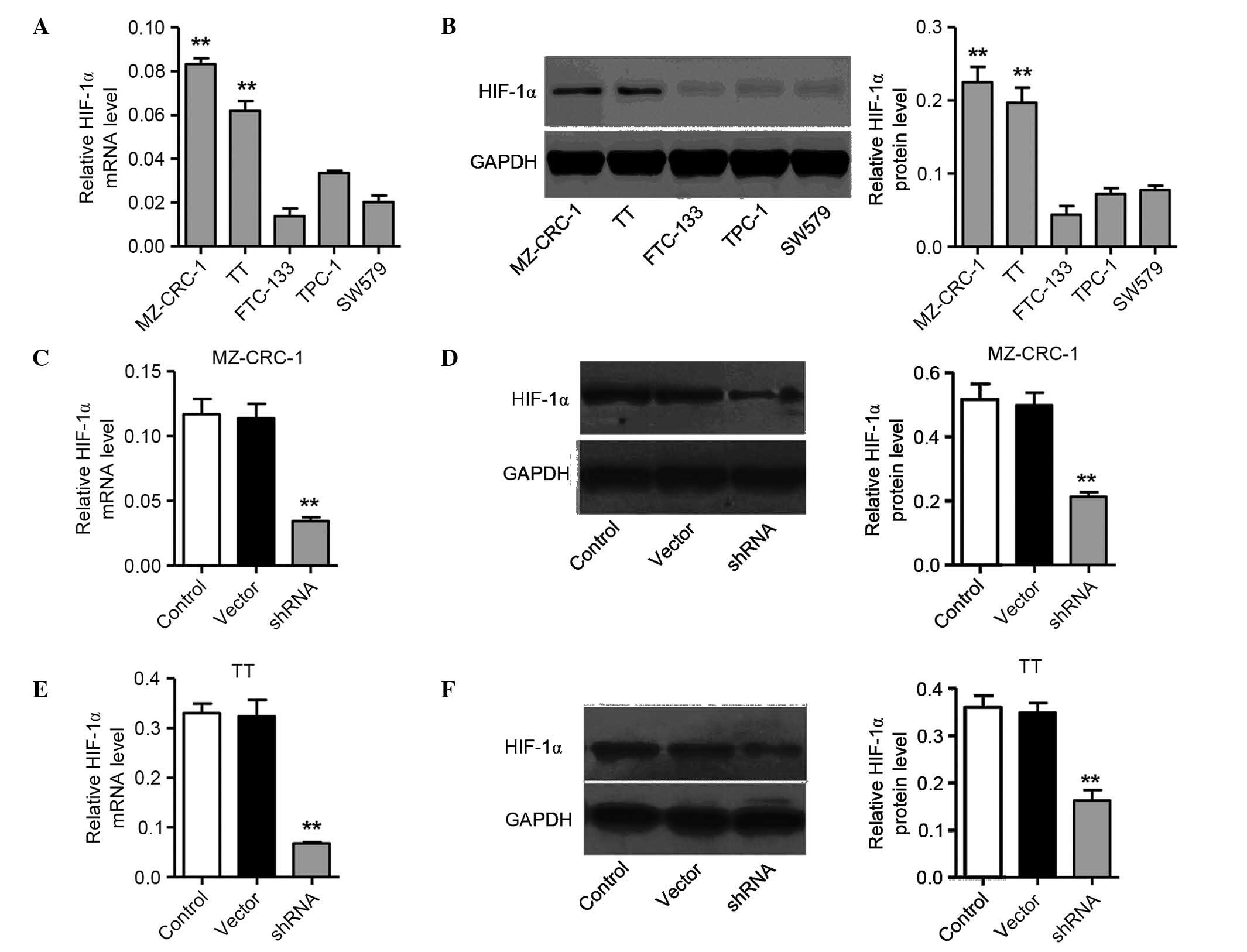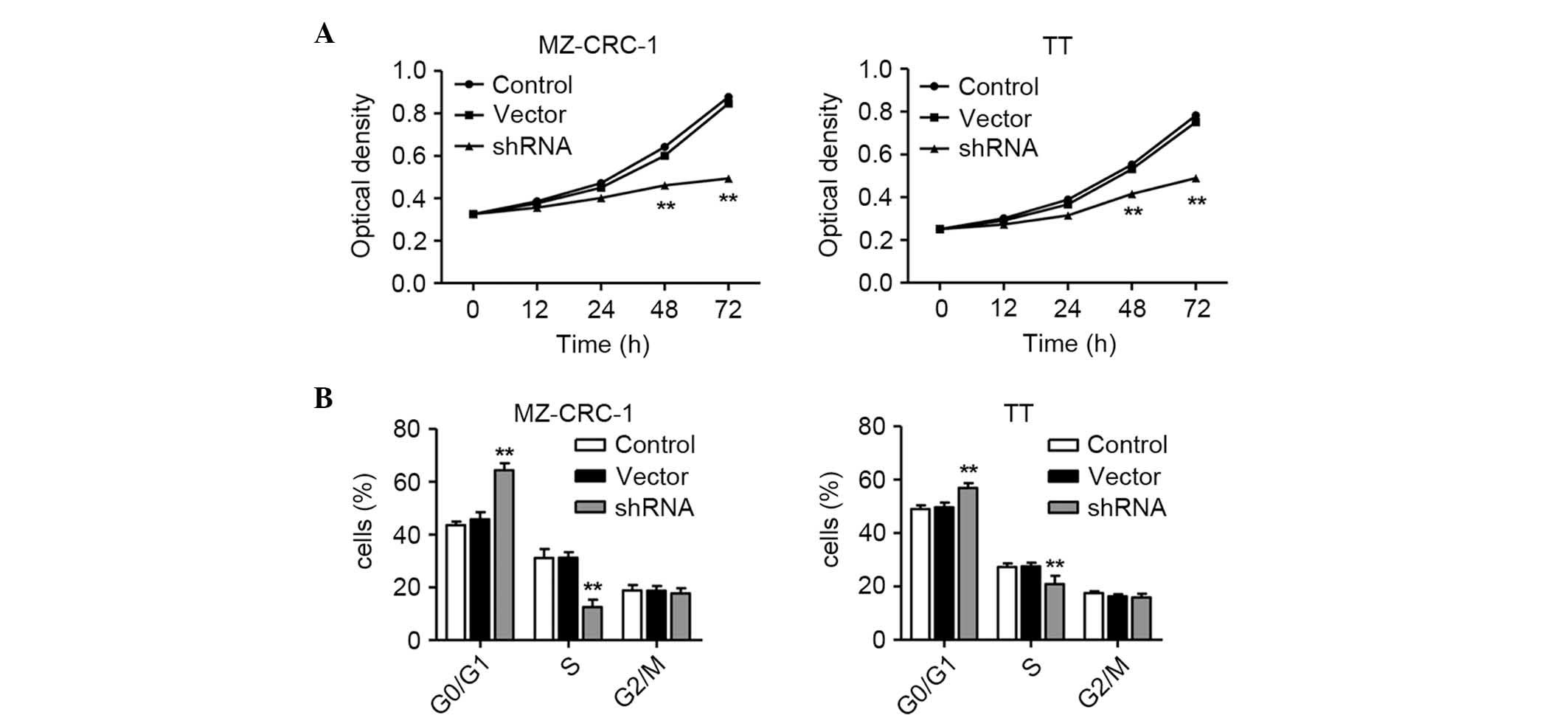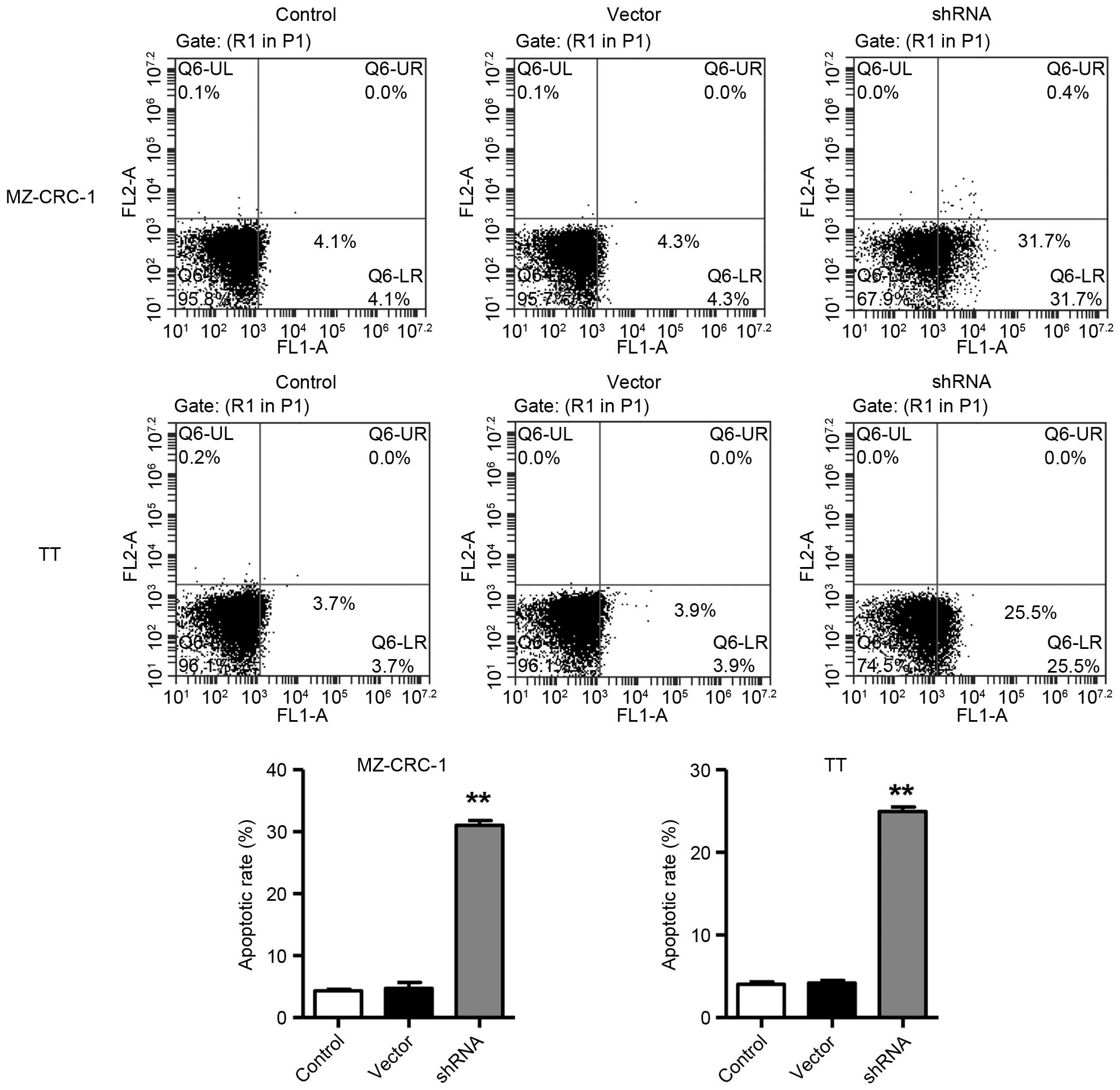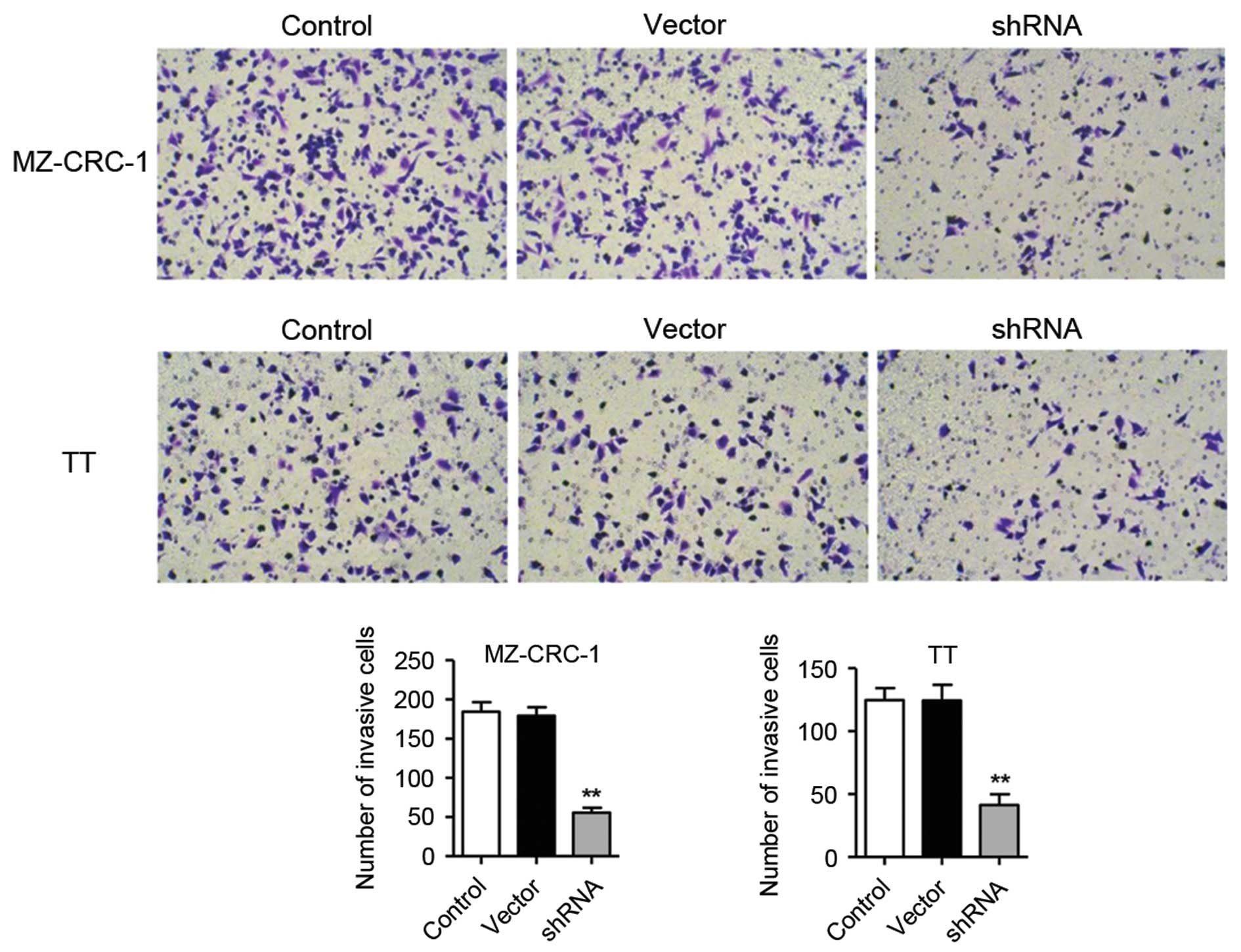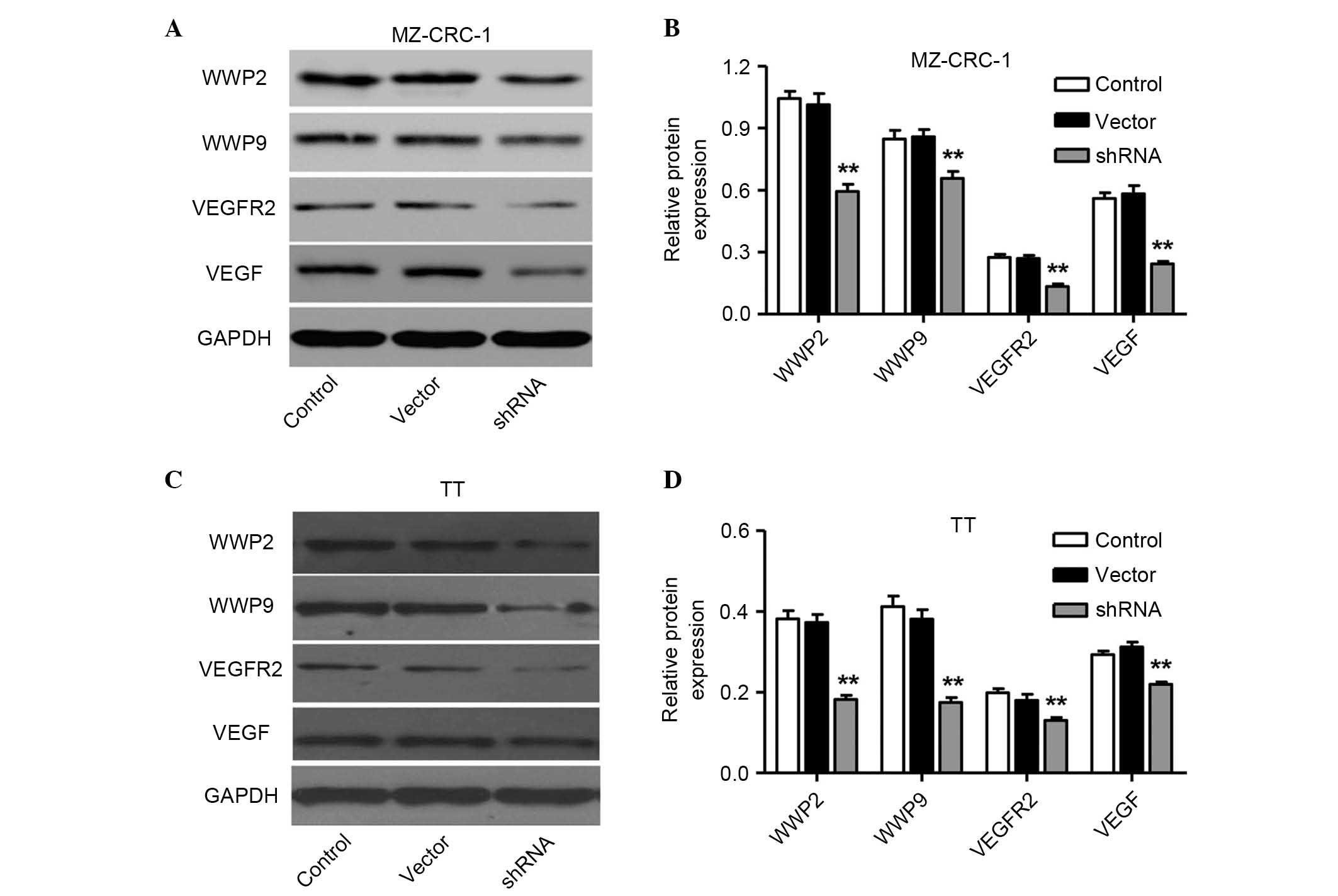|
1
|
Kondo T, Ezzat S and Asa SL: Pathogenetic
mechanisms in thyroid follicular-cell neoplasia. Nat Rev Cancer.
6:292–306. 2006. View
Article : Google Scholar : PubMed/NCBI
|
|
2
|
Sosa JA and Udelsman R: Papillary thyroid
cancer. Surg Oncol Clin N Am. 15:585–601. 2006. View Article : Google Scholar : PubMed/NCBI
|
|
3
|
Hundahl SA, Fleming ID, Fremgen AM and
Menck HR: A National Cancer Data Base report on 53,856 cases of
thyroid carcinoma treated in the US, 1985–1995 [see comments].
Cancer. 83:2638–2648. 1998. View Article : Google Scholar : PubMed/NCBI
|
|
4
|
Marsh DJ, Learoyd DL and Robinson BG:
Medullary thyroid carcinoma: Recent advances and management update.
Thyroid. 5:407–424. 1995. View Article : Google Scholar : PubMed/NCBI
|
|
5
|
Vaupel P: The role of hypoxia-induced
factors in tumor progression. Oncologist. 99:(Suppl 5). S10–S17.
2004. View Article : Google Scholar
|
|
6
|
Vleugel M, Greijer A, Shvarts A, van der
Groep P, van Berkel M, Aarbodem Y, van Tinteren H, Harris AL, van
Diest PJ and van der Wall E: Differential prognostic impact of
hypoxia induced and diffuse HIF-1alpha expression in invasive
breast cancer. J Clin Pathol. 58:172–177. 2005. View Article : Google Scholar : PubMed/NCBI
|
|
7
|
Kimbro KS and Simons JW: Hypoxia-inducible
factor-1 in human breast and prostate cancer. Endocr Relat Cancer.
13:739–749. 2006. View Article : Google Scholar : PubMed/NCBI
|
|
8
|
Semenza GL: Targeting HIF-1 for cancer
therapy. Nat Rev Cancer. 3:721–732. 2003. View Article : Google Scholar : PubMed/NCBI
|
|
9
|
Pouysségur J, Dayan F and Mazure NM:
Hypoxia signalling in cancer and approaches to enforce tumour
regression. Nature. 441:437–443. 2006. View Article : Google Scholar : PubMed/NCBI
|
|
10
|
Amelio I and Melino G: The Sharp blade
against HIF-mediated metastasis. Cell Cycle. 11:4530–4535. 2012.
View Article : Google Scholar : PubMed/NCBI
|
|
11
|
Scarpino S, d'Alena F Cancellario, Di
Napoli A, Pasquini A, Marzullo A and Ruco LP: Increased expression
of Met protein is associated with up-regulation of hypoxia
inducible factor-1 (HIF-1) in tumour cells in papillary carcinoma
of the thyroid. J Pathol. 202:352–358. 2004. View Article : Google Scholar : PubMed/NCBI
|
|
12
|
Burrows N, Resch J, Cowen RL, von
Wasielewski R, Hoang-Vu C, West CM, Williams KJ and Brabant G:
Expression of hypoxia-inducible factor 1alpha in thyroid
carcinomas. Endocr Relat Cancer. 17:61–72. 2010. View Article : Google Scholar : PubMed/NCBI
|
|
13
|
Yang QC, Zeng BF, Shi ZM, Dong Y, Jiang
ZM, Huang J, Lv YM, Yang CX and Liu YW: Inhibition of
hypoxia-induced angiogenesis by trichostatin A via suppression of
HIF-1a activity in human osteosarcoma. J Exp Clin Cancer Res.
25:593–599. 2006.PubMed/NCBI
|
|
14
|
Kyzas PA, Stefanou D, Batistatou A and
Agnantis NJ: Hypoxia-induced tumor angiogenic pathway in head and
neck cancer: An in vivo study. Cancer Lett. 225:297–304. 2005.
View Article : Google Scholar : PubMed/NCBI
|
|
15
|
Ioannou M, Papamichali R, Kouvaras E,
Mylonis I, Vageli D, Kerenidou T, Barbanis S, Daponte A, Simos G,
Gourgoulianis K and Koukoulis GK: Hypoxia inducible factor-1 alpha
and vascular endothelial growth factor in biopsies of small cell
lung carcinoma. Lung. 187:321–329. 2009. View Article : Google Scholar : PubMed/NCBI
|
|
16
|
Litz J and Krystal GW: Imatinib inhibits
c-Kit-induced hypoxia-inducible factor-1alpha activity and vascular
endothelial growth factor expression in small cell lung cancer
cells. Mol Cancer Ther. 5:1415–1422. 2006. View Article : Google Scholar : PubMed/NCBI
|
|
17
|
Payton JE, Grieselhuber NR, Chang LW,
Murakami M, Geiss GK, Link DC, Nagarajan R, Watson MA and Ley TJ:
High throughput digital quantification of mRNA abundance in primary
human acute myeloid leukemia samples. J Clin Invest. 119:1714–1726.
2009. View
Article : Google Scholar : PubMed/NCBI
|
|
18
|
Harris AL: Hypoxia-a key regulatory factor
in tumour growth. Nat Rev Cancer. 2:38–47. 2002. View Article : Google Scholar : PubMed/NCBI
|
|
19
|
Zagzag D, Zhong H, Scalzitti JM, Laughner
E, Simons JW and Semenza GL: Expression of hypoxia-inducible factor
1alpha in brain tumors: Association with angiogenesis, invasion and
progression. Cancer. 88:2606–2618. 2000. View Article : Google Scholar : PubMed/NCBI
|
|
20
|
Jensen RL, Ragel BT, Whang K and Gillespie
D: Inhibition of hypoxia inducible factor-1alpha (HIF-1alpha)
decreases vascular endothelial growth factor (VEGF) secretion and
tumor growth in malignant gliomas. J Neurooncol. 78:233–247. 2006.
View Article : Google Scholar : PubMed/NCBI
|
|
21
|
Song T, Zhang X, Wang C, Wu Y, Cai W, Gao
J and Hong B: MiR-138 suppresses expression of hypoxia-inducible
factor 1α (HIF-1α) in clear cell renal cell carcinoma 786-O cells.
Asian Pac J Cancer Prev. 12:1307–1311. 2011.PubMed/NCBI
|
|
22
|
Chen B, Yuping S and Ni J: Rapamycin
decreases survivin expression to induce NSCLC cell apoptosis under
hypoxia through inhibiting HIF-1α induction. Mol Biol Rep.
39:185–191. 2012. View Article : Google Scholar : PubMed/NCBI
|
|
23
|
Ghafar MA, Anastasiadis AG, Chen MW,
Burchardt M, Olsson LE, Xie H, Benson MC and Buttyan R: Acute
hypoxia increases the aggressive characteristics and survival
properties of prostate cancer cells. Prostate. 54:58–67. 2003.
View Article : Google Scholar : PubMed/NCBI
|
|
24
|
Fan LF, Diao LM, Chen DJ, Liu MQ, Zhu LQ,
Li HG, Tang ZJ, Xia D, Liu X and Chen HL: Expression of HIF-1 alpha
and its relationship to apoptosis and proliferation in lung cancer.
Ai Zheng. 21:254–258. 2002.(In Chinese). PubMed/NCBI
|
|
25
|
Victor N, Ivy A, Jiang BH and Agani FH:
Involvement of HIF-1 in invasion of Mum2B uveal melanoma cells.
Clin Exp Metastasis. 23:87–96. 2006. View Article : Google Scholar : PubMed/NCBI
|
|
26
|
Chang C and Werb Z: The many faces of
metalloproteases: Cell growth, invasion, angiogenesis and
metastasis. Trends Cell Biol. 11:S37–S43. 2001. View Article : Google Scholar : PubMed/NCBI
|
|
27
|
John A and Tuszynski G: The role of matrix
metalloproteinases in tumor angiogenesis and tumor metastasis.
Pathol Oncol Res. 7:14–23. 2001. View Article : Google Scholar : PubMed/NCBI
|
|
28
|
Carmeliet P: VEGF as a key mediator of
angiogenesis in cancer. Oncology. 69:(Suppl 3). S4–S10. 2005.
View Article : Google Scholar
|
|
29
|
Poulaki V, Mitsiades CS, McMullan C,
Sykoutri D, Fanourakis G, Kotoula V, Tseleni-Balafouta S, Koutras
DA and Mitsiades N: Regulation of vascular endothelial growth
factor expression by insulin-like growth factor I in thyroid
carcinomas. J Clin Endocrinol Metab. 88:5392–5398. 2003. View Article : Google Scholar : PubMed/NCBI
|
|
30
|
Gonzalez-Perez RR, Xu Y, Guo S, Watters A,
Zhou W and Leibovich SJ: Leptin upregulates VEGF in breast cancer
via canonic and non-canonical signalling pathways and
NFkappaB/HIF-1alpha activation. Cell Signal. 22:1350–1362. 2010.
View Article : Google Scholar : PubMed/NCBI
|















